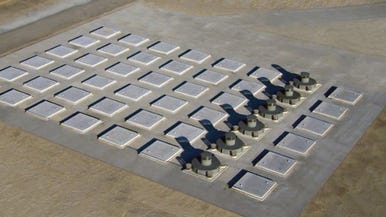Beyond Nuclear's public comment #3, re: NRC's Holtec/ELEA CISF DEIS, Docket ID NRC-2018-0052 -- re: complexity and risk of multiple required cask-to-cask canister transfers
Submitted via: <>
Please acknowledge receipt of these comments. Thank you.
Centralized Storage
With the scientifically unsound proposed Yucca Mountain radioactive waste dump now canceled, the danger of "interim" storage threatens. This means that radioactive waste could be "temporarily" parked in open air lots, vulnerable to accident and attack, while a new repository site is sought.
.................................................................................................................................................................................................................
Submitted via: <>
Please acknowledge receipt of these comments. Thank you.
Submitted via <Holtec-CISFEIS@nrc.gov>
Dear NRC Staff,
On behalf of our members and supporters in New Mexico, and beyond throughout the Lower 48 states along transport routes (road, rail, and/or waterway) that would be used to haul irradiated nuclear fuel and other highly radioactive waste (such as Greater-Than-Class-C so-called "low" level radioactive waste to the Holtec/ELEA CISF), we protest NRC's woefully inadequate, to nearly non-existent, treatment of highly radioactive waste transport risks central to the proposed scheme.
This violates the long-established legal requirement under the National Environmental Policy Act (NEPA) that NRC take a "hard look" at the Holtec CISF proposal, including its inextricably linked high-risk transportation component, impacting most states in the Lower 48.
NRC cites a 2008 Final Supplemental Environmental Impact Statement on the proposed Yucca Mountain, NV dump targeting Western Shoshone Indian land. NRC cites the 2008 DOE document as part of its excuse for not having to do a Holtec-specific transport analysis in 2020 in its own DEIS for the Holtec/ELEA CISF.
In 2017, Fred Dilger, utilizing that same 2008 DOE document, on behalf of the State of Nevada Agency for Nuclear Projects, published a set of route maps, showing road and rail routes admitted by DOE as the most likely to be used to haul highly radioactive wastes to Yucca Mountain, NV.
Dilger's route maps are posted online under the year 2017, here:
http://www.state.nv.us/nucwaste/trans.htm
It should be noted that the further away from the American Southwest such shipments originate, the more similar or even identical the routes for hauling highly radioactive wastes, whether bound for NV or NM.
To round out the complete picture, DOE also published barge route maps in its Feb. 2002 Final EIS on Yucca. Beyond Nuclear has posted these barge route maps for potential barge shipments into ports on bays, rivers, harbors, lakes, and seacoasts across the country, at the following online link:
For its part, Holtec's Environment Report accounts for routes to NM from only four of our country's total of 131 atomic reactors (95 still operating, 2 under construction, 34 permanently shutdown) -- three at San Onofre, CA and one at Maine Yankee -- but NRC's DEIS didn't even include this sole, inadequate map! (See Holtec's solitary map, linked here (Holtec Environment Report, Figure 4.9.1., TRANSPORTATION ROUTES FOR SNF). Compare it to this more comprehensive map, produced by the State of NV re: the Yucca dump targeting Western Shoshone land, based on the same 2008 DOE Final Supplemental EIS that NRC cites in its 2020 Holtec DEIS: http://www.state.nv.us/nucwaste/news2017/ymroutes17.png ).
NRC's DEIS, and Holtec's ER, essentially excluding the high risks of transport, and not even being transparent about transport routes, represents segmentation (the dividing up of a major federal action into smaller parts, so that the proposal doesn't seem so significant or impactful after all). This is a violation of NEPA, as long ruled so by the federal courts.
Please acknowledge receipt of these comments. Thank you.
Holtec International, owner of the Pilgrim Nuclear Plant, and conducting its decommissioning and high-level radioactive waste management, has also proposed a highly controversial consolidated interim storage facility for commercial irradiated nuclear fuel in New Mexico.
I request an acknowledgement that you have received this public comment, made on behalf of Beyond Nuclear's members and supporters in NM, as well as along the transport routes that would be used to haul high-level radioactive waste bound for the Holtec/ELEA CISF, through most states.
As reported by the Carlsbad Current Argus:
